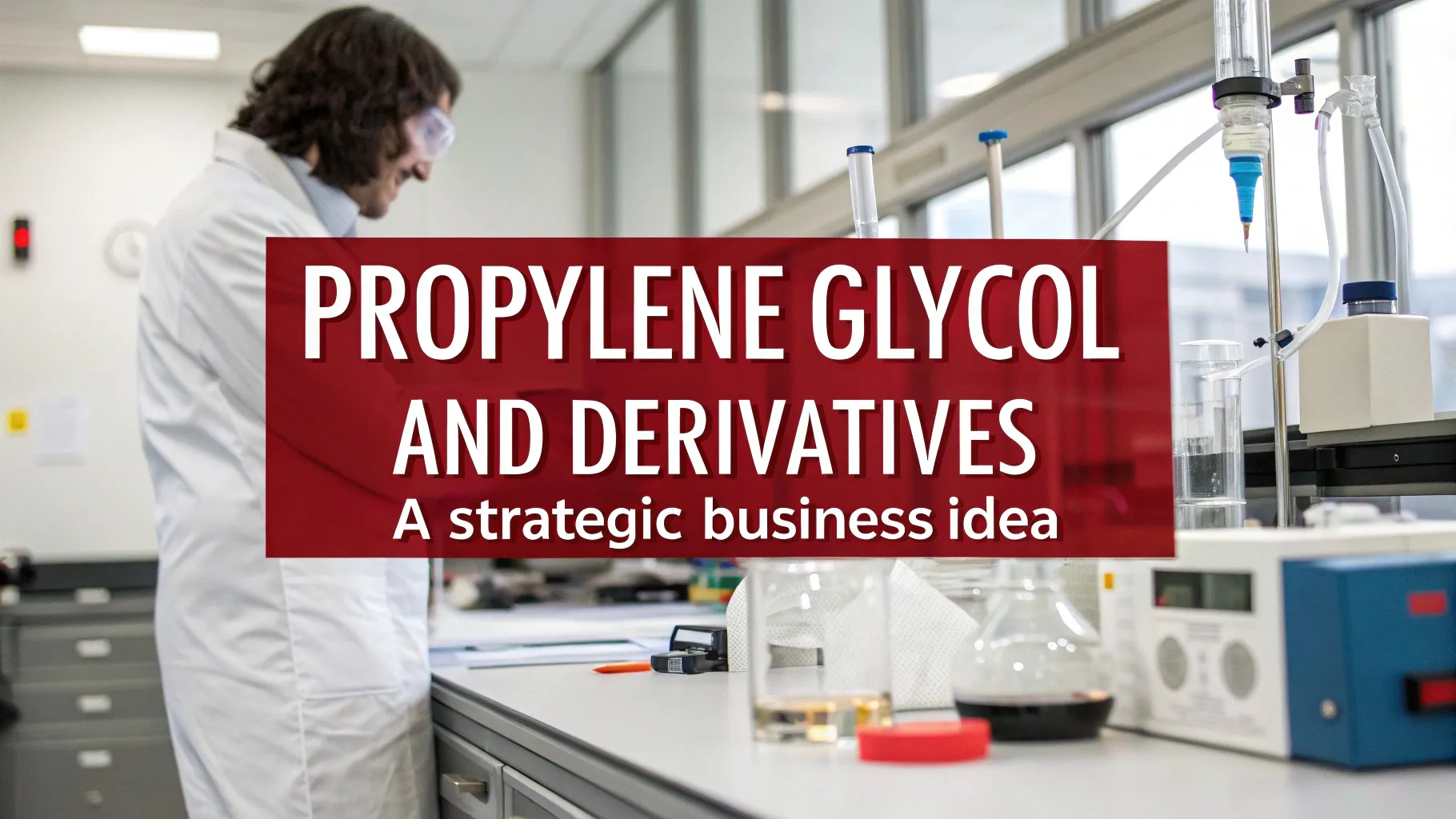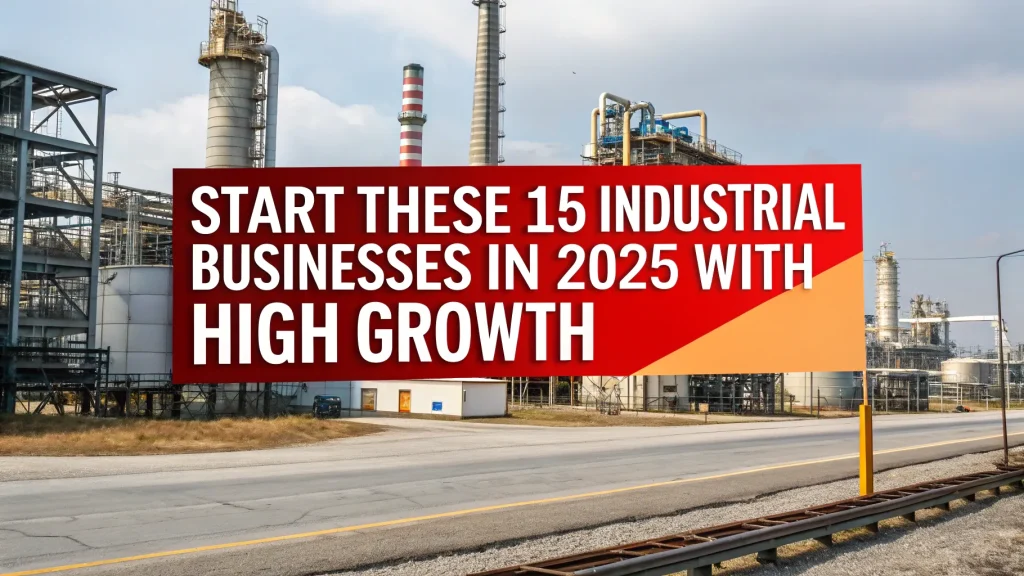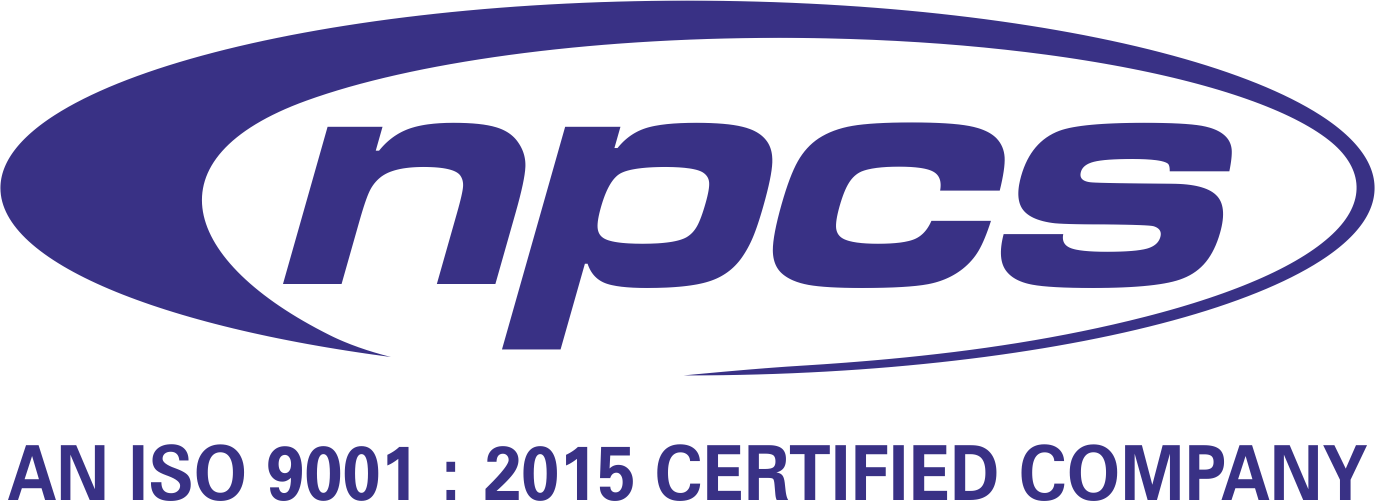Capitalizing on the Propylene Glycol Opportunity
In India’s growing chemical sector, entrepreneurs are on the lookout for products that are high in demand and can be scaled up. One such opportunity is Propylene Glycol which is a colorless odorless hygroscopic liquid. PG has applications across multiple critical sectors from Pharmaceuticals to food processing to cosmetics, plastics, and even automobiles.
As the country’s self-reliance in chemicals, increasing domestic demand along with goals of import substitution create strategic and economic value in propylene glycol and its derivatives production. Startups and established businesses looking to venture into specialty or petrochemicals will find investing in propylene glycol manufacturing both technically feasible as well as financially beneficial.
This article attempts to analyze the entire value chain of propylene glycol starting from its demand dynamics to its manufacturing processes along with business setup cost estimations and growth potential for Indian entrepreneurs and chemical startups.
What Is Propylene Glycol?
Another name for PG is 1,2-propanediol which makes it easy to identify Pyopilene Glycope Oxyde s more familiar name. It is an organic compound better known as 1 2 1,2-propanediol produced using pyopilene oxide, adjacent forming part of hybrid hydrocarbons wwith hydrated systems. Its clear syrupy appearance makes it drinkable while also serving several industries directly out of the container making it greatly loved fo its keeping moisture abilities, low toxicity as well as being a good solvent. Propylene Glycol (PG) is offered in two different grades:
- USP/Pharma Grade: Used in pharmaceuticals, cosmetics, and food manufacturing.
- Industrial Grade: Utilized in antifreeze, paints, resins, de-icing fluids, and plastics.
Furthermore, derivatives such as propylene glycol ethers and polypropylene glycols (PPG) are used more frequently in coatings as well as surfactants, lubricants, and personal care formulations.
Market Overview: Propylene Glycol Manufacturing in India
Present Demand and Import Reliance
In comparison to other countries like the US, China, Germany and South Korea, India heavily relies on imports for PG. This highly import-dependent situation puts a strain on domestic production resulting in an imbalance between supply and demand.
As per industry estimates:
- Greater demand from FMCG, automotive pharma and Construction Sectors is anticipated to boost market demand for PG by 6-8% CAGR.
- Current consumption sits at ~100000 MT/year with expectations of reaching 150000+ MT by 2030
- Over 70% of India’s PG consumption needs are serviced through imports indicating strong potential for domestically produced goods.
Due to Government incentives aimed at boosting domestic chemical production under PLI schemes henceforth propylene glycol is recognized as a vital product qualify for reduction of cross-border purchase reliance.
Related: How to Start an Allyl Glycolate Manufacturing Business?
Applications Driving Demand
The uses of propylene glycol in different sectors is it’s versatility:
- Pharmaceuticals: Propylene glycol is utilized as a solvent for oral, injectable, and topical medications.
- Food and Beverages: Functions as a humectant, emulsifier, and flavor carrier.
- Cosmetics and Personal Care: Included in lotions, shampoos, deodorants,and creams.
- Unsaturated Polyester Resins (UPR): Used predominantly in the marine construction industry.
- De-icing and Antifreeze Fluids: Used in aviation and vehicles in cold regions.
- Paints, Inks, and Coatings: Used as solvents and coalescent agents.
Having interdependent industries eliminates fluctuations in demand due to economic downfalls.
Manufacturing Process
Propylene glycol’s primary production is from hydration of propylene oxide (PO), which comes from petrochemical processes using propylene.
There are two main routes:
- Non-catalytic High-Temperature Process
- This involves water addition via propylene oxide above 200 degree centigrade.
- Produces mono-, di-, and tripropylene glycols.
- Most economical for industrial grade PG.
- Catalytic Low-Temperature Process
- Uses lower temperature ~150 degrees centigrade with bases/ acid catalysts.
- Higher selectivity towards MPG makes it easier for food or pharma grade use.
These require purification steps such as distillation or vacuum stripping.
Primary Raw Inputs:
- Propylene oxide (main input)
- Deionized water
- Catalysts for selective processes
By-products:
- Dipropylene glycol and tripropylene glycol, which have specific uses in fragrances or certain polymers.
Considering that propylene oxide is highly flammable, it is important to manage process safety, control exothermic reactions, as well as volatile organic compounds.
Capital Investment & Plant Setup
The capital required depends on capacity, product grade and technology. Below are estimates for a mid-sized PG manufacturing unit with an annual turnover of 10,000 TPA.
Expense Heads:
- Land & Building: Business site cost is between ?4–6 crore
- Equipment & Utilities: Utilities will amount to equipment costs of roughly ?10–12 crore.
- Effluent treatment and safety systems: This system will range from ?1.5–2 crore
- Process automation & Quality control labs: Labs dedicated to these processes should not exceed ?1.5 crore.
- Licenses and Regulatory approvals: This expense head ranges from “?50 lakh – 1 crore”.
- Working capital: for the first six months is approximated between “?4–5 crore”.
Bringing the project total close to statistically based estimates of “20-25 crores” in INR.
It should be highlighted though that smaller modular plants or those which use other derivatives such as PG ethers, or PPGs may start around 8-12 crores creating more accessible options depending on integration and scale.
Regulatory and Compliance Aspects
In India, an entrepreneur looking to set up a PG plant must obtain the following:
- Consent to Establish and Operate from State Pollution Control Boards
- Approvals pertaining to Hazardous Chemical Storage
- Compliance with the Factory Act and the Boiler Act
- Environmental Impact Assessment (EIA) for larger units
- BIS Certification, which is mandatory for pharma/food-grade PG
- FSSAI registration for food-grade derivatives
For ease in utility access, effluent disposal, compliance management, and other regulatory requirements, the plant site should ideally be in areas such as Dahej chemical clusters or PCPIR, and MIDC estates.
Profit Margins and Revenue Potential
Revenue potential differs according to buyer segments, grade of product, and input cost:
- Industrial-grade PG offers gross margins of 12–18%
- Pharma or food-grade PG can yield higher profit margins between 20%-25% due to heightened demand resulting from greater purity levels.
In more niche applications, propylene glycol ethers or polypropylene glycols could derivative would offer even further enhanced returns.
Assuming CAPACITY THROUGHPUT OF 10 TPA at 80% utilization , REVENUES SUBJECT TO MARKETING STRATEGY AND END USE CALCULATIONS suggest market pricing forecasted between ?110-130 results onup To around AYURVEDIC operating margin payments predict revenues surpassing a deal.
Related: What Are Some Chemicals Not Manufactured In India?
Export Potential and Worldwide Demand
There is substantial scope for Indian PG exports as they are still at a nascent stage. With domestic production, prospects for exports include:
- MENA region – Industrial and construction chemicals
- Southeast Asia – Pharmaceutical products and personal care items
- Eastern Europe and Africa – Paints, resins, and antifreeze additives
Building a pharma-grade PG plant that meets GMP compliance and has REACH registration grants access to the EU and US regulated markets. These are especially critical now since global buyers are diversifying away from Chinese sources.
How NPCS Can Aid You in Establishing a PG Manufacturing Unit
Every entrepreneurial journey comes with its own set of hurdles. Launching a chemical manufacturing unit will come with not only technical issues but also financial planning and country-specific regulations. Here’s where Craige Associates becomes a successful partner for new business owners, supporting them on areas of comprehensive consulting service selection. For example, Niir Project Consultancy Services (NPCS) prepares detailed Market Survey cum Techno-Economic Feasibility Reports focused on:
- Evaluating production processes within your capacities as well as technology alternatives
- Assessing raw material sourcing strategies along with optimal design for plant layout to incorporate streamlined processes
- Strategic financial forecasting including cost-benefit ratios alongside risk profiling
NPCS customizes plans based on industry benchmarks coupled with practical case studies which empowers you to have reasonable projections improving startup risk outcomes significantly. From standalone PG units to more complex integrated derivatives like glycols, NPCS provides support across the entire entrepreneurial trajectory from mere ideas towards realization through versatile consultancy offerings specially tailored around each individual clientele need enabling precise outreach alongside highest satisfaction results!
Final Thoughts: Propylene Glycol – A Chemical Investment Opportunity for the Future
The growth of India’s economy along with greater self-reliance within its chemical industry gives propylene glycol manufacturing an attractive investment proposition. Its consistent demand, wide-ranging uses, potential to substitute imports, and income generation through exports makes it suitable for MSMEs and startups aiming to establish a long-term industrial assets portfolio.
There are opportunities to be more competitive internationally and innovate across the value chain with PG used in paints and plastics as well as USP-grade PG for pharmaceutical and food industries.
Now is the best time to invest given the evolving Indian infrastructure, strong government incentives, and industry experts like NPCS providing direction.
Ready to Jump In?
NPCS has project reports on propylene glycol alongside other chemicals which comes with consultancy services making them easy to initiate businesses. Their tailored project reports offer a perfect starting point.
Visit www.niir.org for sample reports, financial models, and industry roadmaps.
Make impactful decisions by scaling strategically after smart initial moves.






